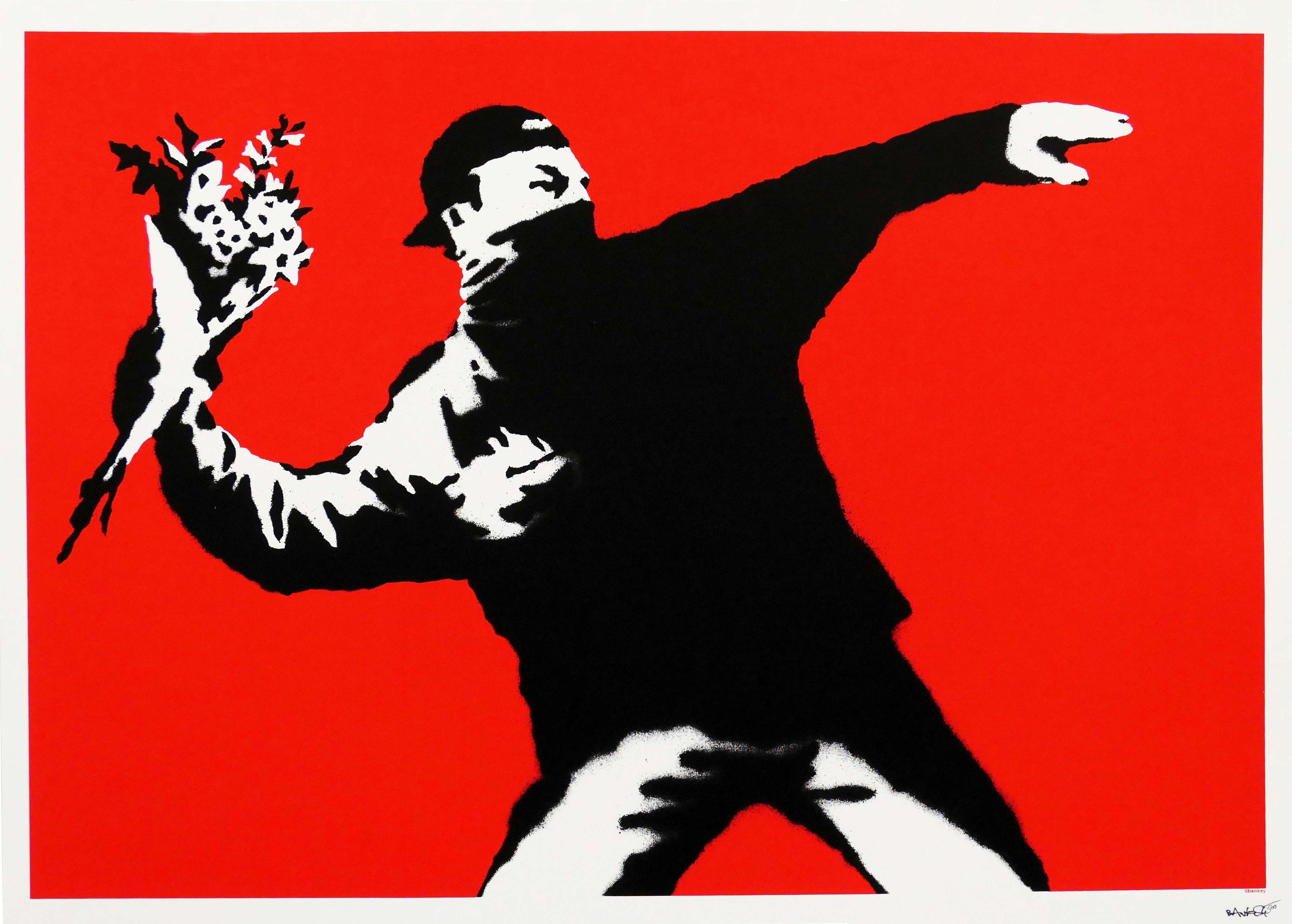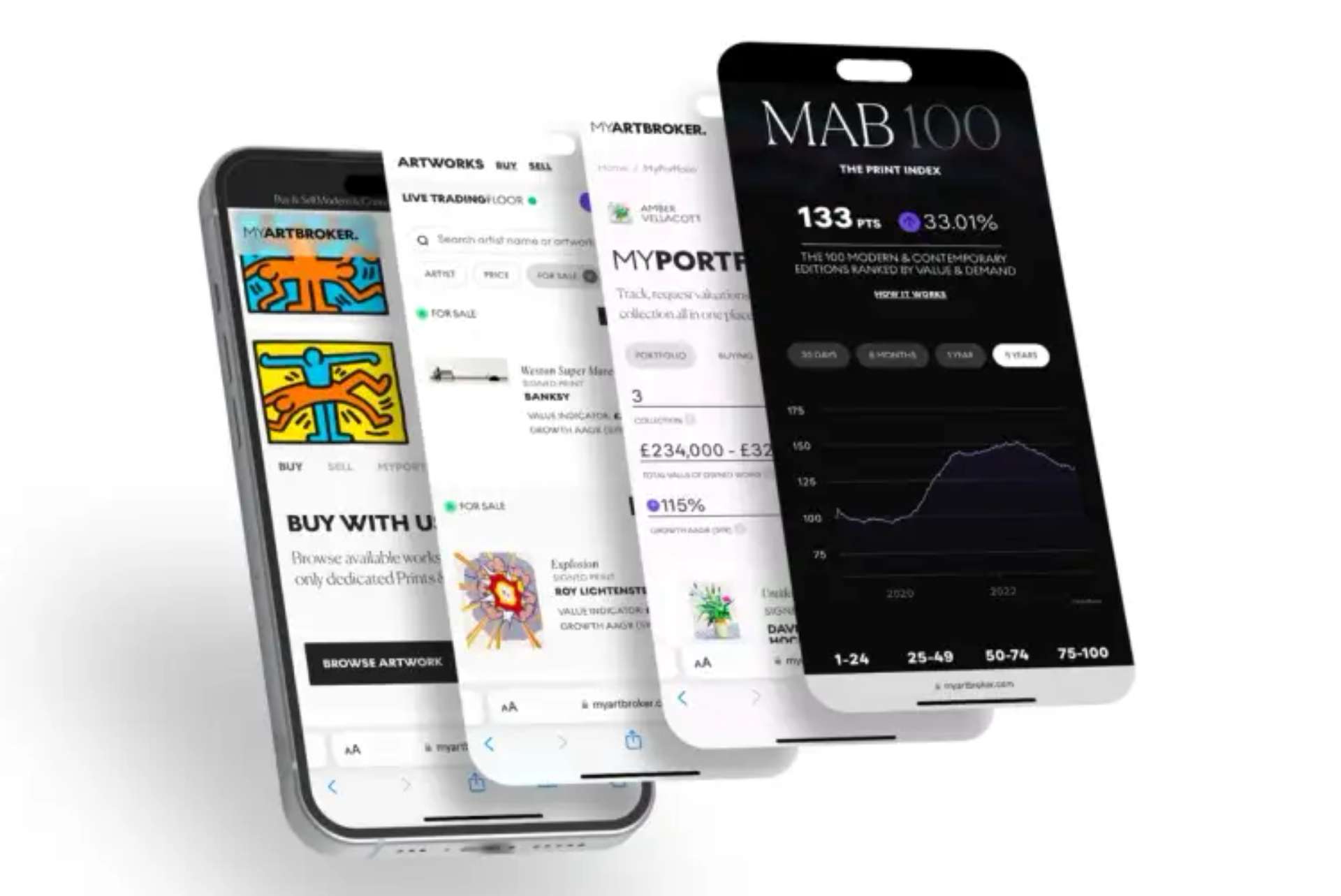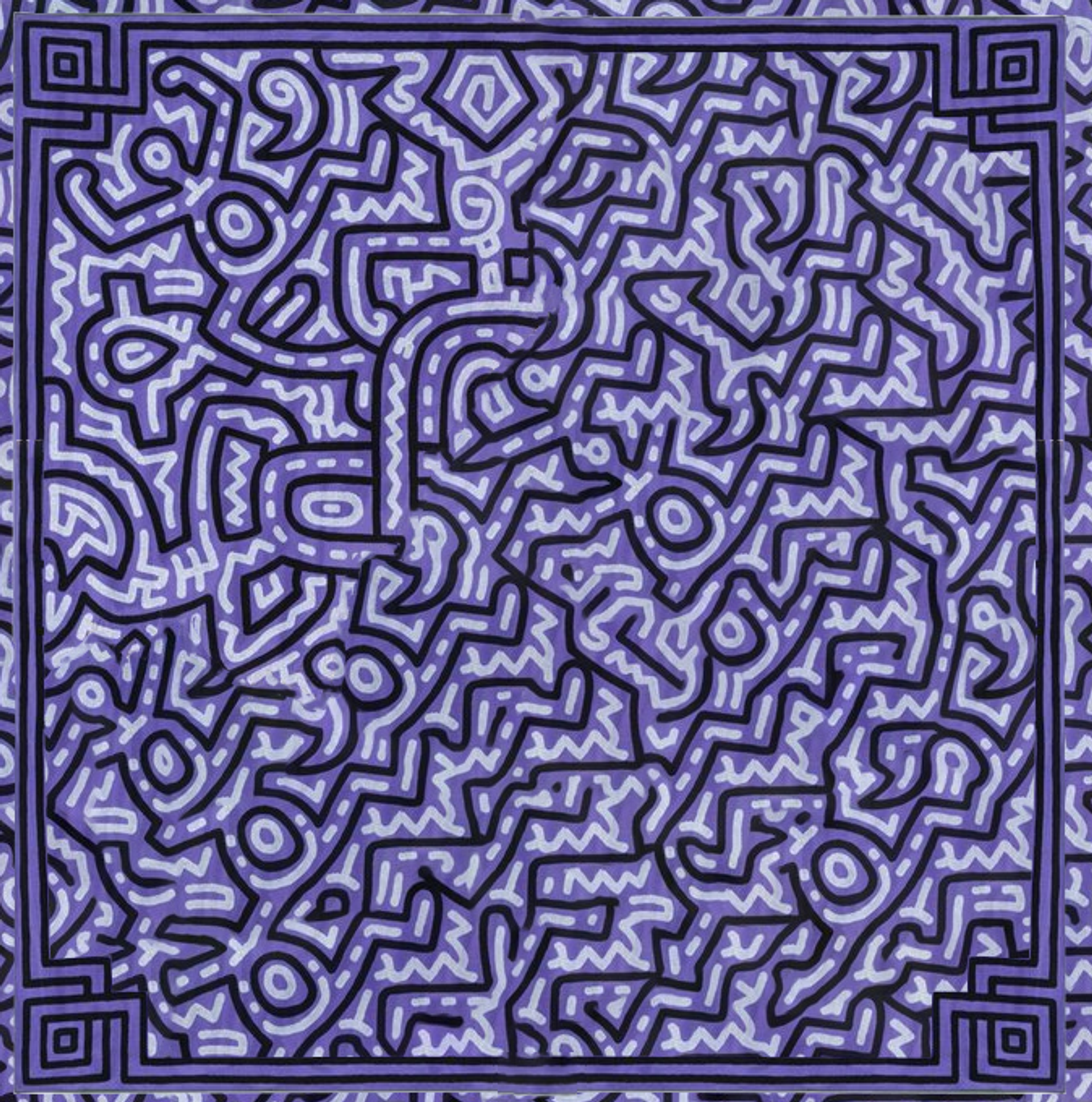Introducing The MAB100: The Art Print Edition Market Index

 MAB100 Print Market Index © MyArtBroker 2023
MAB100 Print Market Index © MyArtBroker 2023 Live TradingFloor
MyArtBroker is pleased to present the MAB100, a tool that offers transparency, precision, and control. In an era where data-driven decisions are paramount, the MAB100 stands as a touchstone for innovation and accessibility in the art market. The traditional art world, shrouded in mystery and subjectivity, has been in great need of tools that provide clarity and objective insights. Powered by our bespoke algorithm, MAB100 addresses this gap: offering a comprehensive and reliable index tailored specifically to the prints and multiples market.
MyArtBroker's Print Market Index
In the wake of the pandemic, our lives underwent a seismic transformation. The familiar confines of social interactions and professional landscapes shifted dramatically as we closed our doors to the world we once knew. Technology, previously confined to our personal spheres, became an integral part of our professional lives. The advent of remote work, the rise of digital meeting platforms, and the embrace of various digital innovations reshaped the way we approached our daily routines. While these changes have been discussed extensively, their revolutionary impact is unprecedented. The concepts of working from home, hybrid work setups, and the widespread adoption of online transactions have morphed into fundamental aspects of our existence. In today's landscape, the use of digital technologies to aid in informed decision-making is crucial. That's why we persist in innovating and expanding our technological capabilities within the art market.
MAB100: What Is A Print Market Index?
In the realm of investments, both seasoned collectors and newcomers to the field often ponder a common question: What exactly is an index, and how does it function? Much like their counterparts in other sectors, art indices share fundamental attributes and purposes, and irrespective of their specific focus, all indices share core similarities in their methodology. One crucial aspect is measurement and comparison. Indices are meticulously crafted tools designed to measure and compare the values or performance of a particular set of assets or entities, whether it pertains to stocks, real estate, or artworks such as prints, i.e. MAB100. Indices act as trustworthy benchmarks, enabling the comparison of changes in value or demand over time.
The MAB100 is the first dedicated print index specifically designed to monitor the top 100 prints, evaluating their liquidity and market significance based on the total expenditure over the past five years. This list includes 100 index constituents ranked by their individual cumulative spending, extracted from auction records and data points obtained from a private sales database, complemented by trend-based analytics. Representing a modern approach, the MAB100 provides direct access to auction data and price discovery from the comfort of your home.
Key Features of the MAB100
The Algorithm
The MAB100 input data consists of real, historic auction sales. Within the index, users will find the artworks current ranking and its image. They will also find an accompanying estimated value next to each artwork, which represents the expected price if the print were to be sold at auction today. This estimate assumes the artwork is in good condition and considers its historical auction and private sales data. The estimated range is based on sales value that includes the buyer's premium but excludes sales tax or VAT. The algorithm behind these estimates, known as SingularityX, utilises a vast dataset.
The price algorithm, SingularityX, sources from over 300 auction houses, as well as 40 other data inputs which affect pricing. It goes beyond public sales, by also considering private sales, valuations, artists' trends, and related print series - including prices for alternative colourways, special editioned prints and corresponding portfolios. By incorporating diverse data points, the algorithm builds a comprehensive picture of an individual artwork’s value. A common challenge with art indices is that oftentimes they will not account for bought-in or unsold works, the technology behind MAB100 considers overlooked data points, such as the last bid price on unsold works and the sell-through rates within specific print series to provide more accuracy towards fair market value.
In essence, the MAB100 provides a comprehensive insight into market dynamics by aggregating data from multiple sources, offering a holistic view of the market landscape. This overview is meant to assist investors, collectors and researchers in accurately monitoring market trends. The baseline value, set at 100 over a five-year period, can also be filtered to 1 year, 6 months, or 30 days for specific analyses. However, investors and market analysts tend to focus on a five-year period as “market trends” are best represented at longer time frames versus “market momentum” that is captured within shorter periods.
The Calculation Methodology
The calculation methodology for the print market index involves a sophisticated approach, utilising a Repeat-Sales Regression (RSR) model. This model analyses individual print sale prices, estimating fluctuations in the value of a representative print over time. By comparing sales prices of the same print at different periods, the RSR method determines price appreciation or depreciation. The index starts at 100 during a chosen baseline period, acting as a reference point. Price changes are calculated using the RSR method, adjusting the index value accordingly. For instance, if artworks appreciate by 5% since the baseline, the index rises to 105, indicating a 5% increase. Ongoing adjustments occur as new sales data is incorporated, always referencing the original baseline value of 100. The value “100’’ isn't a specific monetary amount but serves as a benchmark for stakeholders to comprehend percentage changes effectively.
Auction vs Private Art Sales: The Online Art Market Ushers a New Era
One notable area of transformation in the art market is the auction model. Pre-COVID, sales were in-person affairs, making the recent embrace of online selling seem almost surreal.
Considering prints and multiples sales, Christie’s, Sotheby’s, and Bonhams entered the online arena in 2018, organising four sales spread across the year. This number rose to six in 2019 and five in 2020. By 2021, the count surged to a minimum of 14 online sales, a trend that has persisted into 2022 and 2023. Leveraging our expertise in online sales featuring blue chip artists, we wholeheartedly believe in the transformative power of digitisation within the art market and the transparency that it provides towards smart investing.
Motivated by this belief, we have pioneered a groundbreaking initiative: the MAB100, our exclusive Print Market Index. This innovative tool, aptly named SingularityX, seamlessly integrates with our comprehensive print database. The MAB100 is a unique index that meticulously tracks live changes in the most valued prints over quarterly periods. This pioneering technology offers unparalleled insights, not only guiding you towards the most promising investment opportunities within the print market, but provides data suited for the analysis of wealth and market reports. With the MAB100, our goal is to offer unparalleled expertise, enabling you to make knowledgeable and strategic art acquisitions while ensuring confidence in your database searches.
A Credible Art Market: How The MAB100 Works
What does the MAB100 track?
The MAB100 is an Index that tracks the top 100 prints, ranked by cumulative spend over the previous five years - this is meant as a proxy for “liquidity’’ or most valuable, important, and largest market share. The cumulative spend is recalculated on a quarterly basis (i.e. the constituents of the index are rebalanced every quarter to reflect the latest values and make sure we track the prints of most up-to-date “interest’’).
What does the list include and how are the works ranked?
The list includes the 100 index constituents which have been ranked by cumulative spend over the previous five-year period calculated from matched auction histories, and a blend of data points in our own private sale database, as well as trend indicated analytics. The constituents are to be rebalanced quarterly. The list is ordered by cumulative five year spend, not AAGR as we do with each print.
Where does the index start from and why?
Starting an index at a value of 100 (or any other arbitrary number) is a common practice in the world of financial indices. It doesn't represent a monetary value but serves as a reference point to track changes over time. Starting at 100 is a convention that provides a clear and intuitive way to visualise and understand the relative changes in the index over time. It's especially useful for stakeholders who want to quickly gauge the performance of the market or asset class the index represents without getting bogged down by the complexities of the underlying calculations.
What does the estimated value next to each work represent?
The estimate represents the expected value of an artwork print if sold today at auction. The estimate assumes the print is in the “average’’ condition relative to all previous auction and private sales of that print, and that the auction is taking place in the hypothetical “average’’ dealership or auction house, relative to all in which the print has previously been sold. The figure includes the buyer's premium, but not sales tax or VAT. It is presented as a high/low range, centred around the estimated midpoint which is a value indicator and not a sale to consign price.
What data does the algorithm use to generate estimates?
The model uses our new product SingularityX - which input data consists of real, historic auction sales sourced from over 300 auction houses, as well as 40 other data inputs which affect pricing. It goes beyond historical pricing by considering private sales pricing, valuations, artists' trends, and related print series, including prices for alternative colourways, artist’s proofs, printer’s proofs and corresponding portfolios.
By incorporating diverse data points, the algorithm builds a comprehensive picture of an artwork’s value. It strives to include overlooked data points, such as the last bid price on unsold works, the sell-through rates within series, and all key markers towards a work’s value.
What is the Calculation Methodology?
Print estimates displayed are based on a number of factors:
- The underlying “market index’’ for an individual artist is modelled using a Repeat-Sales Regression (RSR) approach. This approach utilises the sale prices of individual prints to gauge the value fluctuations of a representative print over a specific timeframe. Employing an RSR model offers the advantage of creating an index based on price relatives of the same print, effectively accounting for the varying characteristics among prints.
- The market index is then used to determine the relative volatility of a print’s value, relative to the market as a whole.
- Historic sales prices are then factored in using multiple rolling “look-back’’ periods, allowing the algorithm to factor in relevant price activity for a specific print.
- Relationship structures between different prints are modelled and incorporated into the algorithm, allowing behaviours of closely related prints to be factored in.
The above elements are combined in order to generate a final indicator of value.
How does a Repeat Sales Regression (RSR) index work?
The below shows how the Repeat Sales Regression (RSR) index starts at 100 using by explanation:
- Baseline Establishment: When the RSR index is first created, a baseline period is chosen. This could be a specific year, quarter, or month. The index value for this baseline period is set to 100. This serves as our starting point or reference.
- Price Changes Calculation: Using the RSR method, we calculate the price changes of artworks that have been sold more than once. By comparing the sales prices of the same artwork at different times, we can determine the price appreciation or depreciation.
- Index Value Calculation: If, for example, the RSR method determines that, on average, artworks have appreciated by 5% since the baseline period, the index value would rise to 105 (from the starting value of 100). Conversely, if artworks have, on average, depreciated by 3% since the baseline, the index would drop to 97.
- Ongoing Adjustments: As new sales data becomes available, the RSR method continues to calculate price changes. The index value is adjusted accordingly, always referencing the original baseline value of 100. So, if in the next period, artworks appreciate by another 5%, the index would rise from 105 to 110.25.
- Interpretation: An index value of 110.25 would indicate that artworks, on average, have appreciated by 10.25% since the baseline period. The value “100’’ doesn't represent a monetary amount but is a reference point. It allows stakeholders to easily understand and interpret percentage changes over time.
What does the Index % track?
The movement up or down in the overall index from the previous month's index value.
Why don't you just use auction house data?
If we had built SingularityX on print by print auction data alone, it would be no more intelligent than what’s already out there in the public domain, confusing buyers and sellers, and making it tough to navigate. Data on art pricing predominantly originates from auction houses. However, this poses a dilemma, as these houses have a vested interest in achieving high prices (or low ones, with reserve strategies). This inherent bias in data sources can mislead collectors. The houses also typically only sell approximately 34% of what is being bought and sold in the marketplace - offering only a fraction of the picture.
The art market's data is heavily guarded and not readily available. Relying solely on auction house data limits the understanding of an artwork's true value, which extends well beyond the confines of the auction block. Collectors regularly only have the previous two to three auction results to work from, if they’re lucky, when looking to value their work.
What is the problem we’re trying to solve?
The art market, especially in the prints and multiples blue chip segment, has been shrouded in opacity and uncertainty. The algorithm aims to revolutionise the art world by bringing transparency, data-driven insights, and liquidity to this enigmatic market.
SingularityX seeks to solve several issues collectors, or art sellers, encounter when looking to make decisions - there are several critical challenges when looking to buy and sell in the secondary art market.
One of the primary issues is the lack of visibility regarding the true market value of art. Owners may possess valuable pieces, from Banksy and Warhol to Lowry and Picasso, but struggle to understand why their print is worth a certain amount. Current market information often boils down to what similar pieces are being auctioned for, leaving collectors in the dark.
Unlike existing solutions that often lack confidence and fail to employ sophisticated algorithms, Singularity stands out. It uses an intricate algorithm that processes various datasets, including final bid prices, non-sale data, and estimates. It even factors in different types of volatility, both historical and forward-looking.
What is MyArtBroker trying to achieve with this data?
A Credible Art Market. SingularityX acts as a market maker, a crucial role in illiquid markets like art. By providing bid and ask prices, coupled with the trading floor which shows supply and demand in the private marketplace, it injects liquidity into the market, bridging the gap between buyers and sellers. The product benefits both buyers and sellers, enhancing transparency - and essentially giving collectors ‘inside information’.
Singularity's data-driven approach fosters credibility and trust within the art world, erasing the shadow of opacity and enhancing the market's reputation.
























































